

Examples of etching:

Albrecht Altdorfer (German, c. 1480-1538),
The Entrance Hall of the Regensburg Synagogue,
1519, etching, 6 1/4 x 4 3/8 inches (15.9 x 11.1 cm), Metropolitan
Museum of Art, NY.

Jacques Callot (French, 1592-1635), The Temptation of St. Anthony, 1630,
etching, 45 x 67 cm, Hermitage Museum, St. Petersburg, Russia.
See grotesque.

Anthony van Dyck (Flemish, 1599-1641), Self-Portrait, c. 1630, etching, 9 1/2 x 6 1/8 inches (24.1
x 15.6 cm), Metropolitan Museum of Art, NY. See self-portrait.
Rembrandt Harmensz. van Rijn (Dutch, 1606-1669), Self-Portrait Open Mouthed, As If Shouting: Bust, 1630, etching, image 6.9 x 6 cm, Fine Arts Museums of San Francisco, CA. See self-portrait and Baroque.
Rembrandt Harmensz. van Rijn, Self-Portrait with a Velvet Cap with Plume, 1638, etching, image 13.5 x 10.5 cm, Fine Arts Museums of San Francisco, CA.
Rembrandt Harmensz. van Rijn, Christ Preaching, also called Christ Healing the Sick, and "the hundred guilder print" (because of the high price it is said to have fetched in the seventeenth century), c. 1643-1649, etching, with drypoint and burin, 11 x 15 inches (28 x 39.2 cm), Louvre. Bartsch [catalogue raisonné number] 74.

Rembrandt Harmensz. van Rijn, "Negress" Lying Down, 1658,
etching, drypoint,
and engraving on
golden-toned Japanese paper, 3 3/16 x 6 1/4 inches (8.1 x 15.8
cm), Metropolitan Museum of Art, NY.
Adriaen van Ostade (Dutch, 1610-1685), Rustic Interior with a Man Feeding a Child, 1648, etching and drypoint, Michael C. Carlos Museum, Emory U, Atlanta, GA. See Baroque and genre.

Giovanni Antonio Canal, called Canaletto
(Italian, 1697-1768), Imaginary View of Venice (undivided plate),
1741, etching, 11 13/16 x 17 1/8 inches (30 x 43.5 cm), Metropolitan
Museum of Art, NY.

Giovanni Battista Piranesi (Italian, 1720-1778), The Round Tower, plate III of Carceri
(Prisons), 1749-1760, etching, engraving, sulphur tint or open bite,
burnishing, 21 7/8 x 16 7/16 inches (55.6 x 41.8 cm), Metropolitan
Museum of Art, NY.
Giovanni Basttista Piranesi, The Colosseum, 1761, etching, from Le vedute di Roma, Michael C. Carlos Museum, Emory U, Atlanta, GA. An architect as well as an etcher, Piranesi's etchings of Rome and its ruins contributed to the revival of neoclassicism.

Francisco de Goya y Lucientes (Spanish, 1746-1828),
The
Sleep of Reason Produces Monsters (O Sonho da Razao Produz Monstros),
1796-1797, first edition,
number 43 from the series "Los Caprichos", etching
and aquatint.
See Spanish art.

James McNeil Whistler (American, 1834-1903,
active in England), Drouet, 1859, etching and drypoint, 8 7/8 x 6 inches (22.5 x 15.2 cm),
Los Angeles County Museum of Art.

James Abbott McNeill Whistler, Adam and Eve Tavern, 1879,
etching, sheet: 9 1/4 x 13 1/2 inches (23.49 x 34.29 cm), plate: 6 15/16 x 11 15/16 inches (17.62 x 30.32 cm), Los Angeles County Museum of Art.
Max Klinger (German, 1857-1920), A Glove (Ein handschuh), 1881 (1924 edition), set of ten etchings with aquatint, 142 x 349 mm, Spencer Museum, KS.
Joseph Pennell (English, 1857?-1926).
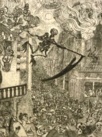
James Ensor (Belgian, 1860-1949), Death Chasing the Flock of Mortals, 1896, drypoint and etching, plate: 9 7/16 x 7 3/16 inches (23.9 x 18.2 cm), Museum of Modern Art, NY. Ensor was a forerunner
of Expressionism
and Surrealism. See death.
Käthe Kollwitz (German, 1867-1945), Selbstbildnis (Self-Portrait), 1921, etching on paper, plate 8 1/2 x 10 1/2 inches (21.7 x 26.8 cm), National Museum of Women in the Arts, Washington, DC. See Expressionism and self-portrait.

Emil Nolde (German, 1867-1956), E.N. (Selbstporträt) (E. N. (Self-Portrait)),
1908, etching
with tonal effects on iron, image 30.8 x
23.5 cm, printer, Otto Felsing, Fine Arts Museums of San Francisco,
CA. See Expressionism
and self-portrait.
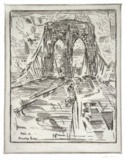
John Marin (American, 1870-1953), Brooklyn Bridge (Mosaic), 1913, etching
and drypoint,
edition: c. 20, plate:
11 1/4 x 8 7/8 inches (28.6 x 22.5 cm), Museum of Modern Art,
NY. Publisher: Alfred Stieglitz at "291," NY.
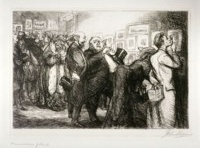
John Sloan (American , 1871-1951), Connoisseurs of Prints, 1905, etching,
image 12.7 x 17.6 cm, printer, Peter J. Platt, Fine Arts Museums
of San Francisco, CA. See The
Eight.
John Sloan, Fifth Avenue Critics, 1905, etching, image 12.7 x 17.6 cm, Fine Arts Museums of San Francisco, CA.

John Sloan, Turning Out the Light, 1905, etching,
image 12.5 x 17.5 cm, Fine Arts Museums of San Francisco, CA.

Paul Klee (German-Swiss, 1879-1940), Komiker
(Comic), 1904, etching,
15.3 x 16.8 cm, Tehran Museum of Contemporary Art, Iran. See
Bauhaus
and Swiss art.

Pablo Picasso (Spanish, 1881-1973), The Frugal Repast (Le Repas Frugal),
1904, etching, plate: 18 3/16 x 14 13/16 inches, sheet: 25 11/16
x 19 11/16 inches, Metropolitan Museum of Art, NY.
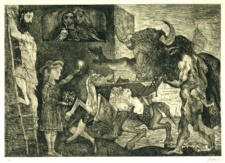
Pablo Picasso, Minotauromachy, 1935, etching and engraving, edition: c. 55, plate:
19 1/2 x 27 3/8 inches (49.6 x 69.6 cm), Museum of Modern Art,
NY.

Pablo Picasso, Satyr and Sleeping Woman, 1936, etching,
31.2 x 41.5 cm, Tate Gallery, London. See satyr.

Pablo Picasso, Neo-Classical Painter in his Studio,
1963, etching, 41.9 x 57.1 cm, Tate Gallery, London. See easel, model, Neoclassicism, and studio.
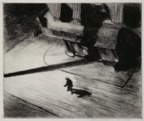
Edward Hopper (American, 1882-1967), Night Shadows, 1921, etching, proof,
6 7/8 x 8 1/4 inches (17.5 x 21 cm). See shadow.
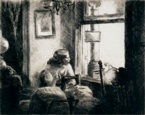
Edward Hopper, East Side Interior, 1922, etching, 8
x 10 inches.

Giorgio Morandi (Italian, 1890-1964), Natura
Morta con il Pannegio a Sinistra, 1927, etching, 24.2
x 35.6 cm. See Metaphysical Painting.

Giorgio Morandi, Still Life with Very Fine Hatching, 1933,
etching on paper, image: 24.8 x
23.8 cm, Tate Gallery, London. For nearly fifty years, Morandi
devoted himself to the depiction of still life subjects
— a collection of bottles, jugs, tins and boxes that he kept
in his studio.
See hatching.

Lucian Freud (British, born Germany, 1920-),
Large Head (Leigh Bowery), 1993, etching,
edition: 40, plate:
27 5/16 x 21 1/4 inches (69.4 x 54 cm), Museum of Modern Art,
NY. Publisher: Matthew Marks Gallery, New York.
![]()
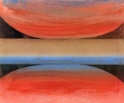
Ed Clark (American, 1926-), Untitled, 1978, etching on paper. See African American art.
Also see feathering and Symbolism.
https://inform.quest/_art
Copyright © 1996-![]()